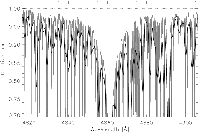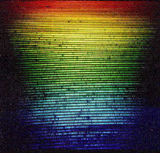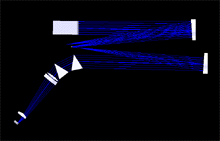|
| High resolution spectrographs
|
|
High resolution spectroscopy offers great insight in the details of stellar
structure and stellar evolution. Compared to low and medium resolution work,
details in stellar spectra become accessible and the comparison between model
and observation can be revised at a unique level. The picture to the right
shows the solar hydrogen Balmer line “beta” at high and medium resolution.
Notably more details are observed in high resolution mode.
|
 |
|
In order to obtain spectra of high resolution, reaching from resolving
powers R=40000 to R=100000 more and more telescopes are equipped with high
resolution spectrographs.
|
 |
Changing from photographic plates to modern electronic CCD detectors, that
are usually produced in squared or rectangular geometry, a spectrograph
configuration, that does not produce one linearly extended long spectrum,
but a set of spectral “stripes” that lie beneath each other became extremely
important. This Échelle type spectrographs allow to use highly efficient
two dimensional and rectangular detectors to register a large part of the
spectrum in one exposure.
|
|
As it becomes necessary to spread the spectrum twice in wavelength space,
first along the major dispersion direction by a grating and a second time
in order to separate the single spectral orders perpendicular to the major
dispersion axes two dispersing elements are needed in an Échelle spectrograh.
|
|
The picture to the right shows the basic geometry of the two spectrographs
FOCES and LAMOST HiRes. The first has been built in our group and is
currently successfully installed at the 2.2m
Calar Alto telescope.
The latter spectrograph is under design in a Sino-German project and is
planned to see its first light at the
LAMOST telescope in
Xinglong station China end of 2008.
|
 |
|
|


